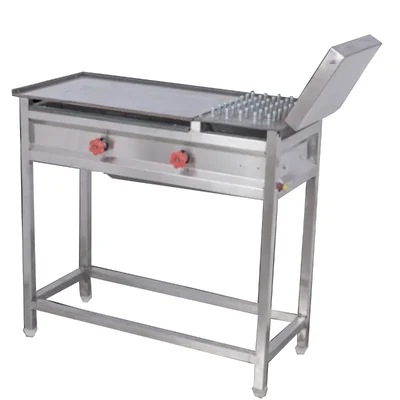- Farm & Garden
- Pumps & Motors
- Food Processing
- Workshop, DIY & MRO

Brand: Generic ( Made in India )
36X17X30 Standing Type Chapati Tawa Bhatti For High-Volume Preparation of Chapatis (Model:Gold)
SKU: TI-3I-41462 Delivery By: Dec 12 - Dec 14
Delivery By: Dec 12 - Dec 14 




MRP : ₹30999 ₹29999
3% OFF!
 Delivery By: Dec 12 - Dec 14
Delivery By: Dec 12 - Dec 14 
Easy Return
& Refund
& Refund

Quality
Assurance
Assurance

Trusted
Delivery
Delivery

After Sales
Assistance
Assistance

Buyer
Protection
Protection
₹29999 (Including GST)
MRP : ₹30999
3% OFF!
Get Extra ₹450 OFF on Prepaid Orders
QTY :
-
1
+
Short Description
Standing Type Chapati Tawa Bhatti
Model Gold
Country of origin: India
Specifications
- Brand: Generic ( Made in India )
- Weight (Approx.) : 55 kg
- Body Material : Stainless Steel 202
- Body Thickness : 1.5 mm
- Body Gauge : 16
- Puffer Cover : Yes
- No of Knob : 2
- Full Body Dimensions : 36X17X30 Inches ( 91.44 X 43.18 X 76.2 Cm)
Description
The Standing Type Chapati (Roti) Tawa Bhatti, Model Gold, is a robust and highly efficient commercial cooking appliance specifically engineered for high-volume preparation of chapatis, rotis, parathas, and other flatbreads. Constructed predominantly from high-grade stainless steel, it ensures exceptional durability, even heat distribution, and ease of cleaning, making it an indispensable asset for bustling commercial kitchens, large-scale catering services.
Features
:Extended Large Cooking Surface (Tawa): Boasts an impressive 36x17 inch cooking surface, significantly larger than standard models. This extended tawa allows for the simultaneous cooking of a greater number of chapatis or rotis, maximizing throughput and efficiency for high-demand environments.
Integrated High-Efficiency Gas Bhatti (Burner System): Features a powerful and precisely engineered gas burner system situated beneath the elongated tawa. This ensures rapid and highly uniform heat distribution across the entire 36-inch cooking surface, leading to quick cooking times and consistent browning of large batches of flatbreads.
Premium Stainless Steel Construction: Built entirely with high-grade stainless steel for the tawa, body, and standing frame. This provides superior durability, excellent resistance to corrosion, high temperatures, and the rigors of commercial use, while also simplifying maintenance and ensuring hygienic operation.
Optimized Standing Type Design (36x17x30 inches): Its free-standing structure offers a comfortable working height (30 inches) and a practical footprint (36x17 inches). This design makes it easy to integrate into various commercial kitchen layouts, providing a dedicated, high-capacity, and ergonomically sound station for flatbread production.
Applications
:High-Volume Restaurants & Eateries: Indispensable for large Indian and South Asian restaurants, catering halls, and busy eateries that require a continuous and substantial supply of fresh chapatis, rotis, parathas, and other regional flatbreads for their extensive clientele.
Large-Scale Catering & Events: Ideal for major catering operations, banquet halls, and large events where thousands of fresh flatbreads need to be prepared efficiently to serve a significant number of guests, ensuring freshness and quality.
Institutional & Community Kitchens: Perfect for large canteens, hostels, military messes, corporate kitchens, and religious institutions that prepare meals for very large groups, enabling efficient bulk production of rotis and other flatbreads.
Commercial Food Processing : Can be a core component in small to medium-scale food processing units specializing in the production of pre-cooked or semi-cooked chapatis for distribution, leveraging its high output capacity and consistent performance.
Usage
:Safe Ignition & Temperature Management: Before operation, ensure proper gas connection and adequate ventilation. Use appropriate ignition methods to light the gas burners and allow the extended tawa to preheat thoroughly. Adjust the flame settings meticulously to maintain uniform heat across the entire 36-inch surface for optimal cooking results.
Efficient Cooking Workflow: Place rolled dough onto the hot tawa, utilizing the larger surface to cook multiple items simultaneously. Flip flatbreads periodically using long-handled spatulas or tongs for even cooking and proper puffing. Manage multiple items to maximize output efficiently.
Thorough Daily Cleaning: After each use, allow the tawa and unit to cool completely. Scrape off all burnt residue and food particles from the tawa surface using a suitable scraper. Wipe down the entire stainless steel body and tawa with a damp cloth and mild, food-safe detergent, then rinse thoroughly and dry completely to maintain hygiene and prevent material buildup.
Periodic Gas System & Burner Inspection: Regularly inspect all gas connections, hoses, and burner ports for any blockages, leaks, or signs of wear. Verify that the burner flames are blue and consistent across the length of the tawa. Schedule routine professional servicing for the gas system and internal components to ensure safety, optimal combustion efficiency, and prolonged equipment life.

Select attribute






